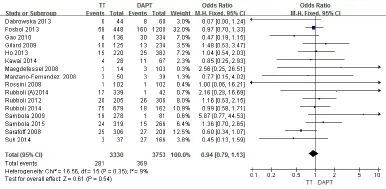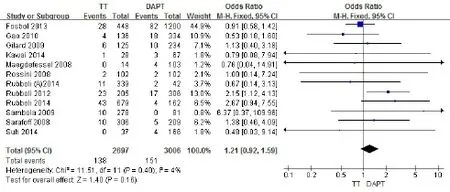PCI术后三联与双联抗凝策略疗效比较的Meta分析
2016-12-15李姮韩聪聪任焘君徐延敏
李姮,韩聪聪,任焘君,徐延敏
PCI术后三联与双联抗凝策略疗效比较的Meta分析
李姮,韩聪聪,任焘君,徐延敏△
目的比较双联(阿司匹林、氯吡格雷)与三联(阿司匹林、氯吡格雷、华法林)抗血小板聚集方案治疗同时有应用口服抗凝药物(OAC)及双联抗血小板聚集药物(DAPT)指征患者的疗效与安全性。方法检索PubMed、Cochrane、Embase数据库,收集1966年1月—2016年4月发表的有OAC及DAPT应用指征的患者抗凝药物使用的疗效和安全性比较的研究,同时辅以手检纳入文献的参考文献。对文献进行筛选、质量评价与资料提取,采用RevMan 5.1软件进行Meta分析,主要终点事件为全因死亡率,次要终点事件包括缺血性卒中、主要出血事件、心肌梗死以及支架内血栓形成。结果共纳入16项研究,共7 083例患者(三联3 330例,双联3 753例),中位随访期1.6年,平均年龄73.2岁。Meta分析显示:三联抗凝与双联抗凝策略相比,全因死亡率[OR(95%CI)=0.94(0.79~1.13),P=0.54]、心肌梗死发生率[OR(95%CI)=1.21(0.92~1.59),P=0.16]、支架内血栓事件发生率[OR(95%CI)=1.02(0.55~1.90),P=0.94]差异均无统计学意义,相对于采取双联抗凝策略的患者,应用三联抗凝策略能降低缺血性卒中风险[OR(95%CI)=0.44(0.30~0.63),P<0.001],增加主要出血事件风险[OR(95%CI)=1.31(1.07~1.61),P=0.008]。结论针对同时具有应用OAC及DAPT指征的患者,使用三联抗凝策略在降低卒中风险的同时会增加出血的风险。
血管成形术,经腔,经皮冠状动脉;血小板聚集抑制剂;卒中;出血;Meta分析;三联抗凝;双联抗凝
房颤是临床最常见的心律失常,可引起心血管疾病恶化,提高卒中风险,增加死亡率。长期口服抗凝药物能够明显降低房颤患者血栓栓塞事件发生率,ACTIVE W试验[1]首次肯定了口服抗凝药物(OAC)相对于双抗治疗而言,能够显著降低接受经皮冠状动脉介入(PCI)治疗的房颤患者的心血管事件发生率,然而,随着疾病谱的演变,目前大部分房颤患者合并冠心病,发生急性心肌梗死或行冠状动脉支架植入术,存在双抗治疗指征。房颤患者PCI术后应用三联抗血小板聚集方案使出血风险增加5倍,然而去除华法林,应用双联抗血小板聚集方案可显著增加卒中或血栓栓塞事件风险,目前同时具有应用OAC与双联抗血小板聚集药物(DAPT)指征的患者群体总数逐渐增加,而这类患者的抗凝药物选择上面临进退两难的境地。尽管目前指南[2]多推荐应用三联抗凝策略,但其证据多来自单中心小型研究,尚需大规模临床试验。本研究采用Meta分析的方法,对同时具有应用OAC及DAPT指征的患者应用两联或三联抗凝方案的安全性及有效性进行进一步评价。
1 资料与方法
1.1 检索策略检索PubMed、Cochrane、Embase数据库,收集1966年1月—2016年4月公开发表的有OAC及DAPT应用指征的患者抗凝药物的使用疗效和安全性比较的研究。检索策略为(“percutaneous coronary intervention”OR“PCI”OR“angioplasty”OR“coronary stenting”OR“stents”)AND(“anticoagulation”OR“warfarin”OR“triple therapy”OR“OAC”)AND(“antiplatelet”OR“dual therapy”OR“dual antiplatelet therapy”)。
1.2 资料提取提取内容包括:作者姓名、发表日期、国家、研究设计类型、随访时间、终点时间、血栓栓塞风险、出血风险等相关资料。主要终点事件为全因死亡率,次要终点事件包括缺血性卒中、主要出血事件、心肌梗死以及支架内血栓形成。安全性指标为:主要出血事件发生率。疗效指标为:全因死亡率、缺血性卒中发生率、支架内血栓形成、心肌梗死事件发生率。
1.3 文献筛选与质量评价方法由两名研究者分别独立筛选检索到的文献,通过阅读题目及摘要初步排除不合格文献,通过进一步仔细阅读文献内容分别对纳入文献进行选择,意见不一致的文献由第三研究者阅读后提供意见讨论决定是否纳入,对于纳入的文献同时辅以手检纳入文献的参考文献。文献研究质量评价由两名研究者独立完成。纳入标准:(1)双联抗凝治疗为阿司匹林、氯吡格雷,三联抗凝策略为阿司匹林、氯吡格雷、华法林。(2)患者群体全部接受PCI治疗且房颤患者比例>50%。(3)报告的主要终点事件为全因死亡率,次要终点事件为主要出血事件。排除标准:(1)排除分组标准为是否应用华法林。(2)随访期<0.5年或患者总体<100例。
1.4 统计学方法采用Cochrane协作网提供的RevMan 5.1软件进行相关分析。采用Cochrane标准,以P>0.1且I2<50%为研究具有同质性标准,采用固定效应模型进行合并,否则认为多个研究间无同质性,采用随机效应模型进行Meta分析。以比值比(OR)作为统计量,并计算95%可信区间(CI),应用漏斗图分析是否存在发表偏倚。
2 结果
2.1 文献检索结果应用前文中的检索策略,PubMed数据库中初步筛选出786篇英文文献,Embase数据库中检索出1 680篇文献,Cochrane数据库中共检索出133篇文献,排除1 027篇重复文献,根据题目及摘要排除不相关文献1 381篇,排除综述及Meta文章105篇,进一步阅读原文,排除纳入人群不符文献24篇,分组不符文献15篇,随访时间<0.5年及患者数量<100例的研究共21篇,未提供终点事件具体发生例数的研究10篇,最终纳入16篇文献。文献具体情况见表1。
2.2 纳入文献的基本情况纳入的16篇文献中,其中4篇为单中心研究,12篇为多中心研究,共纳入7 083例患者,平均年龄为73.2岁,中位随访期为1.6年,TT(三联)组患者3 330例,DAPT(双联)组患者3 753例。
2.3 Meta分析结果
2.3.1 疗效指标结果比较16项研究全因死亡率之间存在同质性(χ2=16.56,P=0.35,I2=9%),采用固定效应模型进行统计分析,各项有OAC适应证及PCI术后患者抗凝策略选择中,TT组与DAPT组之间全因死亡率差异无统计学意义(OR=0.94,95%CI:0.79~1.13,P=0.54),见图1。16项研究缺血性卒中发生率之间存在轻度异质性(χ2=24.46,P=0.06,I2= 39%),采用随机效应模型进行Meta分析,与DAPT组相比,TT组的缺血性卒中发生率显著降低(OR= 0.44,95%CI:0.30~0.63,P<0.001),见图2。9项研究报道了2组患者之间支架内血栓形成发生率,各研究间无统计学异质性(χ2=5.62,P=0.58,I2=0%),采用固定效应模型进行Meta分析,2组患者支架内血栓形成发生率差异无统计学意义(OR=1.02,95%CI:0.55~1.90,P=0.94),见图3。12项提供心肌梗死发生率数据的研究间未见统计学异质性(χ2=11.51,P= 0.40,I2=4%),采用固定效应模型进行统计学分析,结果示2组间心肌梗死发生率差异无统计学意义(OR=1.21,95%CI:0.92~1.59,P=0.16),见图4。
2.3.2 安全性指标结果比较16项研究均报道了主要出血事件发生率,各研究之间存在同质性(χ2= 20.95,P=0.14,I2=28%),采用固定效应模型进行Meta分析,TT组主要出血事件发生率明显升高(OR=1.31,95%CI:1.07~1.61,P=0.008),差异有统计学意义,见图5。

Tab.1Characteristics of included studies表1 纳入研究的一般情况
2.4 发表偏倚评价和敏感性分析对5种指标进行发表偏倚的漏斗图分析,结果均呈对称倒置图形,未见明显发表偏倚。去除各组权重最大的研究,对结果进行敏感性分析,重新合并数据后结果未发生改变,改用随机效应模型进行分析,结果未发生明显变化,表明本研究稳定性良好。

Fig.1Comparison of all-cause mortality between TT group DAPT group图1 TT组与DAPT组全因死亡率比较

Fig.2Comparison of incidence of ischemic stroke between TT group DAPT group图2 TT组与DAPT组缺血性卒中发生率比较

Fig.3Comparison of in-stent thrombosis between TT group DAPT group图3 TT组与DAPT组支架内血栓形成发生率比较

Fig.4Comparison of myocardial infarction between TT group DAPT group图4 TT组与DAPT组心肌梗死发生率比较
3 讨论
本研究旨在探讨有应用OAC指征的患者PCI术后的抗凝策略问题,通过对纳入文献进行Meta分析,得出结论:相对于应用DAPT策略抗凝治疗的患者而言,TT组患者缺血性卒中发生率风险明显降低,同时主要出血事件发生率明显升高,全因死亡率、心肌梗死发生率及支架内血栓形成发生率未见明显差异。

Fig.5Comparison of major bleeding between TT group DAPT group图5 TT组与DAPT组主要出血事件发生率比较
目前PCI术后患者中很大一部分群体合并应用OAC的指征,适应证以房颤为主,包括瓣膜性心脏病、左室射血分数<0.3,血栓栓塞症等,指南推荐[2]针对此类患者应用金属裸支架以缩短双抗治疗时间、将INR维持在2.0~2.5之间以及减少阿司匹林或氯吡格雷的用量来降低患者出血风险。本研究纳入的16项研究中,8项[3,4,7-9,16-18]研究报道了INR控制范围,其中Suh等[17]的研究中将全部患者INR控制在1.83±0.41的范围内,维持在一个偏低的水平,随访期间TT组主要不良事件发生率较DAPT组明显降低(P=0.024),而主要出血事件发生率未见明显升高。有研究进一步分析主要出血事件原因发现INR>2.6为出血事件的独立危险因素(OR=19.2,95%CI:4.3~44.6,P=0.000 3)[4],Sarafoff等[3]的研究结果亦表明将INR控制在2~2.5之间不增加患者出血风险。Goto等[19]进行的一项研究中,纳入1 057例房颤患者,平均随访时间为5.1年,发现INR达标的患者中随访期间卒中发生率显著低于DAPT组患者(6.9%vs.15.1%,P<0.01),进一步证明了控制INR的必要性。近期,Lamberts等[20]进行的一项纳入12 165例房颤患者的大规模前瞻性研究,将患者根据抗凝策略分为5组,综合分析后发现,OAC和氯吡格雷联用策略既不增加卒中风险,又能减少出血风险。Liu等[21]通过对纳入的18项研究进行Meta分析发现,OAC与氯吡格雷联用有效性及安全性良好,而早期应用三联抗凝策略可显著增加患者出血风险。本研究仅针对双联及三联抗凝治疗进行分析,并未关注其他抗凝策略,尚需进一步研究。Kereiakes等[22]比较了植入药物洗脱支架与金属裸支架两组患者的主要心脑血管不良事件的发生率,是一项国际性、多中心、随机双盲、病例对照研究,纳入11 648例患者,结果显示金属裸支架组与药物洗脱支架组的支架内血栓发生率、出血事件发生率以及主要心脑血管不良事件发生率无明显差异,与指南不相符,尚需进一步大型临床试验研究。
三联抗凝策略对于治疗应用OAC合并DAPT指征患者的安全性与有效性尚需进一步评估,目前新型OAC包括达比加群、阿哌沙班、利伐沙班以及新型ADP P2Y12受体拮抗剂如普拉格雷、替格瑞洛等药物的问世为抗凝策略提供了新的方案,目前相关数据尚不完善。APPRAISE[23]试验为一项纳入1 715例患者的大型RCT研究,旨在探讨阿哌沙班在急性冠脉综合征患者中能否减少心血管事件,全部患者应用阿司匹林,其中76%患者联合应用氯吡格雷,研究通过分析发现阿哌沙班引起的出血风险具有明显的剂量依赖性,同时,明确肯定了阿哌沙班在预防缺血性卒中事件中的作用。Sarafoff等[24]分析了植入药物洗脱支架后应用OAC的患者应用阿司匹林、普拉格雷及华法林抗凝策略的疗效与安全性,发现应用普拉格雷替代氯吡格雷后显著增加出血风险,而未有效降低缺血性卒中事件的发生率。
综上,对有OAC合并DAPT应用指征的患者,三联抗凝策略能够显著降低缺血性卒中风险,同时也增加出血风险。因此,临床上应该在有效评估患者出血与卒中风险的基础上应用个体化治疗方案。同时,本研究检索过程中发现目前针对中国人群的三联抗凝策略应用研究相对匮乏,尚需更多的大规模临床研究。
[1]ACTIVE Writing Group of the ACTIVE Investigators,Connolly S, Pogue J,et al.Clopidogrel plus aspirin versus oral anticoagulation for atrial fibrillation in the Atrial fi brillation Clopidogrel Trial with Irbesartan for Prevention of Vascular Events(ACTIVE W):a randomised controlled trial[J].Lancet,2006,367(9526):1903-1912.
[2]Roffi M,Patrono C,Collet JP,et al.2015 ESC Guidelines for the Management of Acute Coronary Syndromes in Patients Presenting without Persistent ST-segment Elevation:Task Force for the Management of Acute Coronary Syndromes in Patients Presenting without Persistent ST-Segment Elevation of the European Society of Cardiology(ESC)[J].Eur Heart J,2016,37(3):267-315.
[3]Sarafoff N,Ndrepepa G,Mehilli J,et al.Aspirin and clopidogrel with or without phenprocoumon after drug eluting coronary stent placement in patients on chronic oral anticoagulation[J].J Intern Med,2008,264(5):472-480.
[4]Rossini R,Musumeci G,Lettieri C,et al.Long-term outcomes in patients undergoing coronary stenting on dual oral antiplatelet treatment requiring oral anticoagulant therapy[J].Am J Cardiol, 2008,102(12):1618-1623.
[5]Maegdefessel L,Schlitt A,Faerber J,et al.Anticoagulant and/or antiplatelet treatment in patients with atrial fibrillation after percutaneous coronary intervention.A single-center experience[J]. Med Klin(Munich),2008,103(9):628-632.
[6]Manzano-Fernández S,Pastor FJ,Marín F,et al.Increased major bleeding complications related to triple antithrombotic therapy usage in patients with atrial fibrillation undergoing percutaneous coronary artery stenting[J].Chest,2008,134(3):559-567.
[7]Gilard M,Blanchard D,Helft G,et al.Antiplatelet therapy in patients with anticoagulants undergoing percutaneous coronary stenting(from STENTIng and oral anticoagulants[STENTICO])[J].Am J Cardiol,2009,104(3):338-342.
[8]Sambola A,Ferreira-Gonzalez I,Angel J,et al.Therapeutic strategies after coronary stenting in chronically anticoagulated patients:the MUSICA study[J].Heart,2009,95(18):1483-1488.
[9]Gao F,Zhou YJ,Wang ZJ,et al.Meta-analysis of the combination of warfarin and dual antiplatelet therapy after coronary stenting in patients with indications for chronic oral anticoagulation[J].Int J Cardiol,2011,148(1):96-101.
[10]Rubboli A,Magnavacchi P,Guastaroba P,et al.Antithrombotic management and 1-year outcome of patients on oral anticoagulation undergoingcoronarystentimplantation(fromtheRegistro Regionale Angioplastiche Emilia-Romagna Registry)[J].Am J Cardiol,2012,109(10):1411-1417.
[11]Fosbol EL,Wang TY,Li S,et al.Warfarin use among older atrial fibrillation patients with non–ST-segment elevation myocardial infarction managed with coronary stenting and dual antiplatelet therapy[J].Am Heart J,2013,166(5):864-870.
[12]Dabrowska M,Ochala A,Cybulski W,et al.Balancing between bleedingandthromboembolismafterpercutaneouscoronary interventioninpatientswithatrialfibrillation.Couldtriple anticoagulanttherapybeasolution?[J].PostepyKardiol Interwencyjnej,2013,9(3):234-240.
[13]Ho KW,Ivanov J,Freixa X,et al.Antithrombotic therapy after coronary stenting in patients with nonvalvular atrial fibrillation[J]. Can J Cardiol,2013,29(2):213-218.
[14]Kawai H,Watanabe E,Yamamoto M,et al.Major bleeding complications related to combined antithrombotic therapy in atrial fibrillation patients 12 months after coronary artery stenting[J].J Cardiol,2015,65(3):197-202.
[15]Rubboli A,Saia F,Sciahbasi A,et al.Outcome of patients on oral anticoagulation undergoing coronary artery stenting:data from discharge to 12 months in the Warfarin and Coronary Stenting(WAR-STENT)Registry[J].J Invasive Cardiol,2014,26(11): 563-569.
[16]Rubboli A,Schlitt A,Kiviniemi T,et al.One-year outcome of patients with atrial fibrillation undergoing coronary artery stenting: an analysis of the AFCAS Registry[J].Clin Cardiol,2014,37(6): 357-364.
[17]Suh SY,Kang WC,Oh PC,et al.Efficacy and safety of aspirin, clopidogrel,and warfarin after coronary artery stenting in Korean patients with atrial fibrillation[J].Heart Vessels,2014,29(5):578-583.
[18]Sambola A,Mutuberría M,García Del Blanco B,et al.Effects of triple therapy in patients with non-valvular atrial fibrillation undergoingpercutaneouscoronaryinterventionregarding thromboembolic risk stratification[J].Circ J,2016,80(2):354-362.
[19]Goto K,Nakai K,Shizuta S,et al.Anticoagulant and antiplatelet therapy in patients with atrial fibrillation undergoing percutaneous coronary intervention[J].Am J Cardiol,2014,114(1):70-78.
[20]Lamberts M,Gislason GH,Olesen JB,et al.Oral anticoagulation andantiplateletsinatrialfibrillationpatientsafter myocardial infarction and coronary intervention[J].J Am Coll Cardiol,2013,62(11):981-989.
[21]Liu J,Fan M,Zhao J,et al.Efficacy and safety of antithrombotic regimensaftercoronaryinterventioninpatientsonoral anticoagulation:Traditional and Bayesian meta-analysis of clinical trials[J].Int J Cardiol,2016,205:89-96.
[22]Kereiakes DJ,Yeh RW,Massaro JM,et al.Antiplatelet therapy duration following bare metal or drug-eluting coronary stents[J]. JAMA,2015,313(11):1113.
[23]John H,Alexander MM,Richard C,et al.Apixaban,an oral,direct, selective factor Xa inhibitor,in combination with antiplatelet therapy after acute coronary syndrome:results of the apixaban for prevention of acute ischemic and safety events(APPRAISE)trial[J].Circulation,2009,119(22):2877-2885.
[24]Sarafoff N,Martischnig A,Wealer J,et al.Triple therapy with aspirin,prasugrel,and vitamin k antagonists in patients with drugeluting stent implantation and an indication for oral anticoagulation[J].J Am Coll Cardiol,2013,61(20):2060-2066.
(2016-07-16收稿2016-9-17修回)
(本文编辑闫娟)
Meta analysis of the efficacy and safety of triple and double antithrombosis strategies in patients with PCI
LI Heng,HAN Congcong,REN Taojun,XU Yanmin△
Department of Cardiology,the Second Hospital of Tianjin Medical University,Tianjin 300211,China△
ObjectiveTo compare the efficacy and safety of double antiplatelet treatment strategy(DAPT,aspirin, clopidogrel)and triple antiplatelet strategy(aspirin,clopidogrel and warfarin)in patients with oral anticoagulants(OAC). MethodsPubMed,Cochrane and Embase database were searched,and the information from January 1966 to April 2016 was collected.The efficacy and safety of antithrombotic drugs in patients with OAC were compared.At the same time, supplemented data searched by hand were collected and included into references.RevMan 5.1 software was used in this Meta analysis.The primary endpoint events were all cause mortality,and the secondary endpoints included ischemic stroke, major bleeding events,myocardial infarction and in-stent thrombus formation.ResultsA total of 16 studies including 7 083 patients(triple antiplatelet treatment 3 330,double antiplatelet treatment 3 753)in this analysis.The median followup period was 1.6 years,and the average age was 73.2 years.Meta analysis showed that there was no significant difference in all cause mortality rate between dual antiplatelet strategy and triple antithrombotic strategy[OR(95%CI)=0.94(0.79-1.13),P=0.54],no significant difference in myocardial infarction incidence rate[OR(95%CI)=1.21(0.92-1.59),P=0.16],and no significant difference in in-stent thrombosis events between dual antiplatelet strategy and triple antithrombotic strategy[OR(95%CI)=1.02(0.55-1.90),P=0.94].Compared with dual antiplatelet strategy for patients,the triple antithrombotic strategy can significantly reduce the risk of ischemic stroke[OR(95%CI)=0.44(0.30-0.63),P<0.001],and increase major bleeding events[OR(95%CI)=1.31(1.07-1.61),P=0.008].ConclusionIn review of the application of OAC and DAPT in patients with indications of the anti thrombosis strategy,triple antithrombotic strategy can reduce the risk of stroke,and increase the risk of bleeding.
angioplasty,transluminal,percutaneous coronary;platelet aggregation inhibitors;stroke;hemorrhage; Meta-analysis;triple antithrombosis;double antithrombosis
R541.4
A
10.11958/20160694
天津医科大学第二医院心内科(邮编300211)
李姮(1990),女,硕士在读,主要从事冠心病基础与临床研究
△通讯作者E-mail:xuyanminphdmd@sina.com
